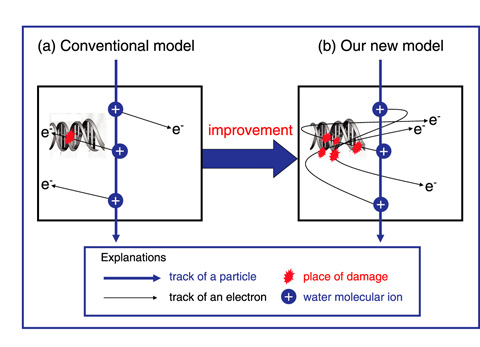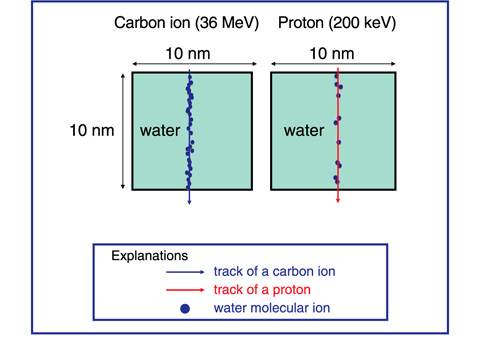
Fig.4-23 Images of DNA damage in the case of (a) conventional model and (b) our new model

Fig.4-24 Positions where the water ions are produced
Cancer therapy with carbon ions has a powerful therapeutic effect. This may result from the fact that carbon ions cause clustered DNA damage, which is defined as multiply damaged sites, within a region corresponding to a DNA length of several nanometers. Clustered DNA damage is thought to be produced by electron impact. Although evidence on the biological significance of clustered DNA damage has been accumulated, it remains largely unknown how clustered DNA damage results after irradiation. We proposed a mechanism and quantitatively showed its feasibility. The mechanism is as follows: the electric field traps the emitted electrons near a radiation track, and these electrons cause a cluster of DNA lesions.
Fig.4-23 shows images of the movement of electrons produced by irradiation of a particle in the case of the conventional model and our new model. A comparison of Fig.4-23 (a) with Fig.4-23 (b) led us to propose that our model may show a high probability of the production of clustered DNA damage.
Fig.4-24 shows some positions where H2O+ ions are produced upon irradiation of water with a 36 MeV carbon ion and a 200 keV proton. The water molecules are ionized approximately every 0.3 nm and 0.8 nm along the tracks of the carbon ion and proton, respectively. We also calculate the number of electrons trapped by the electric fields of H2O+ ions within a diameter of 2 nm from the track. These numbers are 15 and 3 for the carbon ion and proton irradiation, respectively. Since the ionization event often takes place at an energy near 200 keV in the case of proton impact, the number of electrons trapped near the track after the carbon ion irradiation is much larger than that after the proton irradiation. Furthermore, for a carbon ion, the number of H2O+ ions produced by electron impact as calculated by using our model is four times as large as that calculated by using the conventional models. This is because of the fact that the chances of collision of electrons with a H2O molecule increase for the situation shown in Fig.4-23 (b) in the case where a DNA is located near the track. That is, the electrons trapped near the track may cause clustered DNA damage. In future, we intend carrying out simulations involving DNA in a cell and studying the role of the electric fields in the occurrence of clustered DNA damage in greater detail.